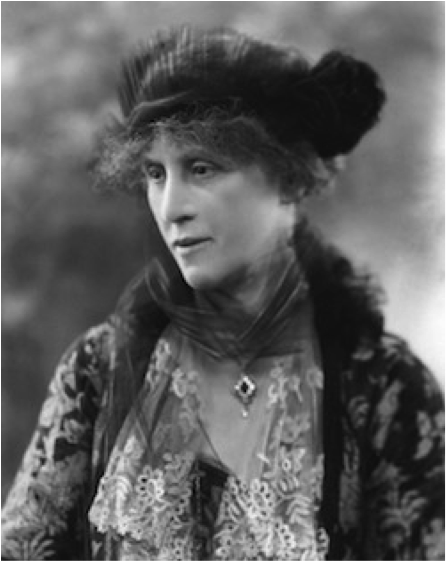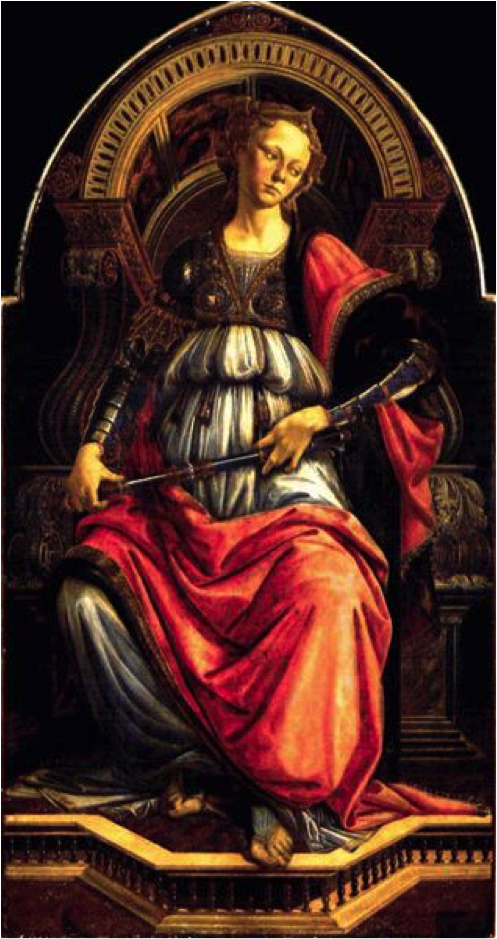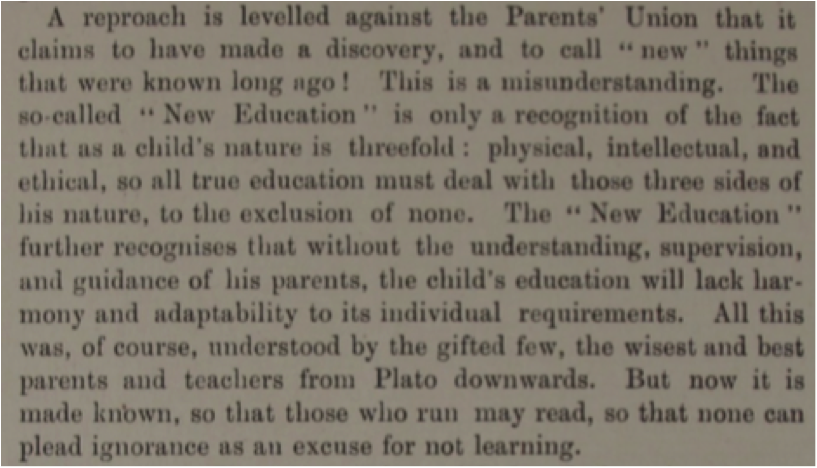Dividing Over Unity

Lady Isabel Margesson was known as Lady for good reason. She was the daughter of the Earl of Buckinghamshire, and in late Victorian England, she was not one to be trifled with. Lady Isabel was keen to educate her children in the most enlightened way possible, so she became conversant with the best ideas in education, old and new. When she discovered Charlotte Mason’s Parents’ National Educational Union (P.N.E.U.), she thought she had found a group of like-minded individuals. She thought she had found a cause worthy of her time, energy, and support.
But had Lady Isabel really found what she was looking for? What did the P.N.E.U. really stand for, anyway? In June of 1892, Mason had published an article in the Parents’ Review answering that question. This article, entitled “P.N.E.U. Philosophy,” is where Mason first coined and described the term “The Great Recognition.” This groundbreaking article was later republished as Chapter 22 of Parents and Children under the title “A Catechism Of Educational Theory.” This article is the earliest definitive expression of Mason’s full theory of education. But Lady Isabel apparently either did not read Mason’s “P.N.E.U. Philosophy,” or she did not consider it to be definitive. Instead, Lady Isabel wrote up her own description of the P.N.E.U. she thought she had joined. In her zeal, she published her write-up in a pamphlet entitled “What is the Parents’ National Educational Union?”


A comparison of Lady Isabel’s document to Mason’s document shows that the two women had quite different understandings of P.N.E.U philosophy. In what ways were their understandings different? Stay tuned — I will explain the most important difference at the end of this article. (Hint: Lady Isabel’s pamphlet includes an important reference to Plato.) First, however, I will trace the exciting story of how Lady Isabel’s pamphlet set in motion division over unity.
The story begins with the P.N.E.U.’s Executive Committee. This was an exclusive and elite set of P.N.E.U leaders who met on a monthly basis to govern and direct the Union. The most famous member of the Executive Committee was the P.N.E.U. founder herself, Miss Charlotte Mason. However, whether by virtue of class, energy, talent, or a combination of the three, Lady Isabel also managed to join the Executive Committee. She attended her first meeting on December 9, 1892.
Less than a year after Lady Isabel joined the Executive Committee, Mason contracted some kind of illness. Due to her health, Mason was unable to attend the December 18, 1893 meeting. With all due Victorian courtesy, the Executive Committee kindly “desired the Sec[retary] to express to Miss Mason their regret at learning of her indisposition and their wishes for her speedy recovery.” In Mason’s absence, the Executive Committee discussed Lady Isabel’s pamphlet — the one entitled “What is the Parents’ National Educational Union?” The minutes of the meeting record the surprisingly enthusiastic outcome of their discussion:
The Sec[retary] was desired to convey to Miss Mason the opinion of the Com[mittee] that Lady Isabel Margesson’s pamphlet ‘What is the P.N.E.U.’ should appear in the Parents’ Review in place of an adv[ertisement] which now appears on the front page.

So they wanted Mason’s approval to have Lady Isabel’s pamphlet appear in the opening pages of each issue of the Parents’ Review . . . . How would Mason respond to such a request? Did Mason support what was in the pamphlet? Did the pamphlet accurately convey “P.N.E.U. Philosophy”? Did it accurately describe the organization that Mason founded?
The Executive Committee would have to wait in suspense for an answer. Mason had chosen a typical Victorian remedy for her “indisposition”: travel. Mason had gone off to Italy. Sometime in the winter or early spring of 1894, she found herself in the Spanish Chapel of Santa Maria Novella in Florence. With her 1892 “Great Recognition” fresh in her mind, Mason was surprised and gratified to discover a fresco that seemed to illustrate a key element of the truth she had uncovered. It was a momentous event in the history of Mason’s theory of education. But it didn’t address the immediate question of Lady Isabel’s pamphlet.
When the Executive Committee met four months later on April 18, 1894, Mason was apparently still in Italy. The Executive Committee was getting impatient, and Lady Isabel’s pamphlet was discussed again (now recast as a leaflet). Lady Isabel seemed to have a sense of urgency. The minutes summarize her remarks and the resulting action:
The draft of proposed new leaflet for distribution & advertisement in Parents Review was submitted, Lady Isabel Margesson suggesting that some more definite statement of principles was necessary to meet such objections as had been made at Cardiff & elsewhere — The leaflet was read aloud & passed & the Secretary instructed to send it to the printer forthwith.

So Lady Isabel thought that “some more definite statement of principles was necessary.” Had she not read Mason’s “P.N.E.U. Philosophy”? It would be hard to imagine a more definite statement than that! But again, the Executive Committee made a resolution. This time, however, the Secretary was not instructed to send Lady Isabel’s leaflet to Mason. This time the Secretary was instructed to send it to the printer for inclusion in the Parents’ Review!
In the month of May, Mason (apparently) returned from Italy and had a heart-to-heart with Lady Isabel. This discussion made it absolutely clear to Mason that the two of them had incompatible views of P.N.E.U. philosophy. Shockingly, however, Mason missed the next Executive Committee meeting, on June 6, 1894. Not surprisingly, Lady Isabel’s leaflet was discussed, but this time, the members of the Executive Committee knew Mason’s stance. In a classic example of Victorian understatement, the secretary reported on the committee’s discussion:
The question of the recent advertisement in Parents’ Review & Leaflet in latent circulation was brought up & the paragraph therein dealing with the ‘Objects’ of the P.N.E.U. was discussed with some warmth & finally adjourned for decision by a future Committee, the Secretary being instructed to give due notice of the same.

Mason acted upon this “due notice.” Less than three weeks later, on June 24, 1894, the Executive Committee met again. This time Mason was present. She brought along a new friend — Henrietta Franklin, who joined the Executive Committee on June 8. This was Franklin’s first meeting. The chairman of the Committee, Dr. Albert Schofield, had also acted upon this “due notice.” He used the three-week window to obtain legal advice. The minutes describe what happened at the meeting:
Dr. Schofield then read a legal opinion he had received on the point as to how far this Executive Committee had powers to alter the Rule 3 as stated in the published Report, & giving it that the Executive had no such power, & that therefore the discussion of the question was out of order.

Dr. Schofield expressed the opinion that the Executive Committee did not have the authority to approve of Lady Isabel’s leaflet. In light of the legal opinion, Dr. Schofield made a motion that Lady Isabel’s leaflet be withdrawn from circulation. His motion was seconded by none other than Henrietta Franklin. A vote was taken…
. . . regarding this Leaflet, which is to be withdrawn from circulation.’ This was put to the meeting & lost by a minority of one vote.

Dr. Schofield’s motion lost by a single vote! The majority believed that Lady Isabel’s leaflet made claims that were perfectly compatible with P.NE.U. Philosophy. According to the majority, this leaflet was nothing to divide over.
Empowered by this victory, Mr. A.F. Shand put forth his own motion. He moved that Lady Isabel’s leaflet be broadened:
Mr. Margesson “That after the names Pestalozzi, Herbert Spencer & Froebel, the words be added ‘and other educational philosophers.”

Shand’s motion was seconded by Lady Isabel’s husband (!) Mr. Margesson. Now Shand’s motion went up for voting:
“Mr. Shand’s amendment was then put & carried by a majority of 9 to 6.”

Shane’s motion won! The Executive Committee had determined that the P.N.E.U. stood for a broad arc of educational tradition that also encompassed Johann Pestalozzi (1746-1827), Herbert Spencer (1820-1903), Friedrich Froebel (1782-1852), and other educational philosophers.
Mason lost. So what? Did it really matter? With so many problems in Victorian education, why nitpick? Lady Isabel had written that all these educational philosophers recognized “that as a child’s nature is threefold: physical, intellectual, and ethical, so all true education must deal with those three sides of his nature, to the exclusion of none.” Why not unite with other energetic educationalists concerned about educating the whole child? Why not identify with all life-giving educational philosophers? Perhaps now was the time for Mason to show her ecumenical colors and to make it clear to the world that she embraced a broad tradition of educational theory.
Or perhaps not. Less than three weeks after losing her vote, Mason took dramatic, stunning, courageous, and unilateral action. On July 9, 1894 Mason circulated a new leaflet. In her leaflet she included legal testimony from an attorney:

She made it clear what P.N.E.U. Philosophy is really about. It is not about some broad tradition that enlightened educational philosophers have known from ancient times. It is not a broad conglomeration of ideas that educate the whole child. Rather, it is something new. Brand new:

Lady Isabel had said that “some more definitive statement of principles was necessary.” Mason vigorously denied this charge, doubtless recalling her own revolutionary article of June, 1892 which decisively outlined “P.N.E.U. Philosophy.”

After Mason circulated her dramatic leaflet, what was Lady Isabel to do? After all, Mason was the founder of the P.N.E.U and the originator of its ideals. . . .
The Executive Committee met again, less than two weeks later, on July 18, 1894. For the second time in a row now, Mason was present. Also present was her new and committed ally, Mrs. Franklin. Dr. Schofield submitted a motion about Lady Isabel’s leaflet — essentially the same motion that had been defeated on June 24. This time his motion was seconded by Ada Ballin. And then he called for a vote. The minutes say the motion carried “nem con,” which means “without anyone in the group disagreeing.” What? No one disagreed? How could that be?
This was put to the meeting without discussion & carried nem: con:
Mr. Macneill [sic] then explained his feelings of those members of the Committee who had abstained from voting with regard to Miss Mason’s circular and tendered the resignations of his wife & himself, of Mr. & the Lady Isabel Margesson, Mr. Gurney . . . .

The motion carried without disagreement because half of the Executive Committee resigned rather than vote. Immediately after the motion carried, Mr. McNeill indicated that he, the Margesson’s, and others were resigning from the P.N.E.U. He then read a prepared letter of resignation in which the group (Lady Isabel included) cited “serious difference of opinion.”
One week later, on July 25, Lady Isabel prepared a written resignation letter. She left a sting, reiterating her April assertion that “some more definitive statement of principles was necessary.” She said Mason would have none of that. She said that Mason wanted “old vagueness . . . to prevail.”
Miss Mason on the contrary desired the old vagueness still to prevail.

But Mason did not want “vagueness” — she wanted the crisp originality of her own P.N.E.U. philosophy. Ten years later, Mason was still reflecting on these words from Lady Isabel. In 1904, Mason took her original 1892 “P.N.E.U. Philosophy” and condensed it still further to a “Short Synopsis” — the famous twenty principles found in the opening pages of her volumes today. In a letter to Franklin, Mason described her twenty principles with a direct reference to the 1894 controversy:
So it seems to me well to draw even an inadequate statement of what we teach and also it seems necessary that this teaching must be protected by the name of the originator, or everyone who speaks for P.N.E.U. has a right to say, ‘I think’ and call it, ‘P.N.E.U. Teaching’ and this must result in the ‘absolute vagueness’ we deprecate.

By saying, “this teaching must be protected by the name of the originator,” Mason paved the way for future generations to refer to this philosophy as a “Charlotte Mason method.”
Mason’s later testimony also indicates that her conflict with Lady Isabel was not her only struggle in the development and promotion of her theory of education. She wrote to Franklin on March 9, 1900, stating:
. . . remembering that I have had to fight every inch of the way we have come and that, though I am resting in much ease and content, chiefly because of that intellectual fealty that I have spoken of, I sit like Botticelli’s Fortitude, sword in [hand] . . .

Mason’s reference to Botticelli’s “Fortitude” is particularly striking when we reflect on what she wrote about this painting in Ourselves:

Botticelli’s picture of Fortitude, and Ruskin’s interpretation of it, are among the lessons which Conscience should get by heart. This ‘Fortitude’ is no colossal figure, standing stark, bristling with combative energy. Noble in stature, she yet sits, weary after long-sustained effort; wistful, too, as who should say, ‘How long?’ But, though resting, she is wary and alert, still grasping the unsheathed sword which lies across her knees. She is engaged in a warfare whose end is not within sight; but hers is not the joy of attack. She is weary indeed, yet neither sorry for herself nor pleased with herself; her regard is simple. She has the ‘single eye’ which looks upon the thing to be done, not upon herself as the doer — the thing to be borne, rather, for Fortitude suffers.
What was Mason’s battle that she would evoke such language? What was her “thing to be done” to which she looked with a “single eye”? Was it (as some have said), “her desire to be inspired and guided by the principles of the past”? Was it that she “went looking into the past and drew an older conception of education into the present”?
To answer this question, I will finally reveal the important paragraph of Lady Isabel’s pamphlet. This is the paragraph that mentions Plato, and I believe it is key to understanding the claim of unity that ultimately divided the P.N.E.U.:
A reproach is leveled against the Parents’ Union that it claims to have made a discovery, and to call ‘new’ things that were known long ago! This is a misunderstanding. The so-called ‘New Education’ is only a recognition of the fact that as a child’s nature is threefold: physical, intellectual, and ethical, so all true education must deal with those three sides of his nature, to the exclusion of none. The ‘New Education’ further recognizes that without the understanding, supervision, and guidance of his parents, the child’s education will lack harmony and adaptability to its individual requirements. All this was, of course, understood by the gifted few, the wisest and best parents and teachers from Plato downwards. But now it is made known, so that those who run may read, so that none can plead ignorance as an excuse for not learning.

Lady Isabel said that what the P.N.E.U. propagated was not really new. It had always been “understood by the gifted few, the wisest and best parents and teachers from Plato downwards.” Lady Isabel saw an arc of enlightened educationalists beginning with Plato and continuing unbroken to the present. Lady Isabel’s concept is of a classical tradition of education beginning with Plato. Her concept sounds eerily similar to what we hear today from those who wish to submerge Mason’s theory of education into Christian Classical Education.
But If Mason’s aim was unity with Plato and enlightened thinkers across the centuries, then she and Lady Isabel were unified in their aim. If Mason’s aim was unity with all who wished to educate the whole child, then she and Lady Isabel were unified in their aim. If Mason discovered principles that had been articulated before, then Mason and Lady Isabel were unified in their aim.
Instead, Mason divided over unity. She divided because she had discovered a set of “principles not worked on before.” She divided because she had found something Plato did not have. She divided because she had found a Code of Education in the Gospels.